Muscatine, Iowa
Muscatine /ˌmʌskəˈtin/[4] is a city in Muscatine County, Iowa, United States. The population was 22,886 at the 2010 census,[5] an increase from 22,697 in 2000.[6] The county seat of Muscatine County,[7] it is located along the Mississippi River. The local business association states that the name Muscatine is not used by any other community.[8]
Muscatine, Iowa | |
|---|---|
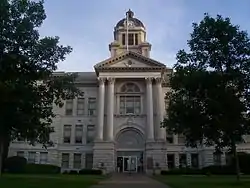 Muscatine County Courthouse | |
| Nickname(s): "The Pearl of the Mississippi", "The Pearl City" | |
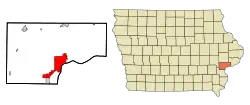 Location in the U.S. state of Iowa | |
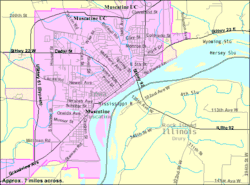 | |
| Coordinates: 41°25′26″N 91°3′22″W | |
| Country | |
| State | |
| County | Muscatine |
| Incorporated | 1839 |
| Government | |
| • Mayor | Diana Broderson |
| Area | |
| • City | 19.23 sq mi (49.82 km2) |
| • Land | 18.18 sq mi (47.08 km2) |
| • Water | 1.06 sq mi (2.73 km2) |
| Elevation | 581 ft (177 m) |
| Population | |
| • City | 22,886 |
| • Estimate (2019)[3] | 23,631 |
| • Rank | 22nd in Iowa |
| • Density | 1,299.98/sq mi (501.91/km2) |
| • Metro | 54,741 |
| Time zone | UTC−6 (CST) |
| • Summer (DST) | UTC−5 (CDT) |
| ZIP code | 52761 |
| Area code(s) | 563 |
| FIPS code | 19-55110 |
| GNIS feature ID | 0465186 |
| Website | www |
Muscatine is the principal city of the Muscatine Micropolitan Statistical Area (2010 census population 54,132) as of 2011 the estimate was 54,184, which includes all of Muscatine and Louisa counties, making it the 208th-largest Micropolitan Statistical Area.[9]
History
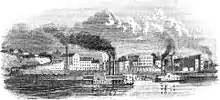
Muscatine began as a trading post founded by representatives of Colonel George Davenport in 1833. Muscatine was incorporated as Bloomington in 1839; the name was changed to reduce mail delivery confusion, as there were several Bloomingtons in the Midwest. Before that, Muscatine had also been known as "Newburg" and "Casey's Landing".
The origin of the name Muscatine is debated. It may have been derived from the Mascouten Native American tribe.[10] The Mascoutin lived along the Mississippi in the 1700s.[11]:66 In 1819 Muscatine Island was known as Mascoutin Island.
In the 1838 General Land Office map, the town is labelled Musquitine, which may be a variation of Musquakeen, an alternative name for Muscatine Island; Musquakeen may have derived from the Meskwaki indigenous people who lived close by.[12] Major William Williams, who was visiting in 1849 when the town was still called both Bloomington and Muscatine, claimed, "Muscatine in English is Fire Island," in his list of the meanings of Siouan language names.[13]
Williams wrote a brief description of the settlement:
Bloomington is a fine town, one of the most important points in the state. Its situation on one of the great bends of the Mississippi has great commercial advantages; [it] is the seat of justice of Muscatine County. Contains about 2000 inhabitants, is the natural depository for a vast amount of trade from the surrounding country, has many neat residences and several spacious brick mercantile establishments- a large steam mill, one smaller one, two printing establishments, 6 churches, 4 physicians, 8 lawyers, an neat court house and jail, Masonic lodge, etc.... This town is very prettily situated, in part on a level on the river for two streets back, when the ground rises and the remaining street is elevated in benches, the whole standing in a rise enclosed by a range of high bluffs which runs around it in a semicircular form, forming beautiful sites for residences. From the bluff there is a beautiful view of the town below and of the Mississippi for miles up and down. All steam boats land here, passing up and down.[13]
— Maj. William Williams
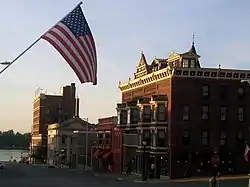
From the 1840s to the Civil War, Muscatine had Iowa's largest black community, consisting of fugitive slaves who had traveled the Mississippi from the South and free blacks who had migrated from the eastern states. One of the most prominent community leaders was Alexander G. Clark Sr., born free in Pennsylvania. He was a barber, a respected position at the time, and eventually became a wealthy timber salesman and real estate speculator. In 1848 he was among the founders of the local African Methodist Episcopal Church, which had been established as the first independent black denomination in the US.
In the antebellum period he assisted fugitive slaves, and petitioned the state government to overturn racist laws before the Civil War. In 1863, Clark helped organize Iowa's black regiment, the 60th United States Colored Infantry (originally known as the 1st Iowa Infantry, African Descent), though an injury prevented him from serving.
In 1868, he gained desegregation of Iowa's public schools by suing the Muscatine school board after his daughter Susan was turned away from her neighborhood school. Eleven years later, in 1879 his son Alexander Jr. became the first black graduate of the University of Iowa College of Law and its first black graduate from any department. Clark Sr. went to the college and became its second black law graduate five years later, despite being 58 years old. He said that he wanted to serve “as an example to young men of his own race.” Clark rose to prominence in the Republican Party, serving as a delegate to state and national conventions.
In 1890, Clark was appointed ambassador to Liberia by President Benjamin Harrison. He was one of four Muscatine residents to be appointed as a diplomatic envoy between 1855 and 1900, a remarkable feat for a town of such small size: George Van Horne was consul at Marseilles, France during the 1860s; Samuel McNutt served at Maracaibo, Venezuela in 1890; and Frank W. Mahin represented his country in Reichenberg, Austria in 1900.
Less than a year after arriving in Liberia, Clark died of fever. His body was returned to the US, where he was buried in Muscatine's Greenwood Cemetery. In 1975 the city moved his former house about 200 feet, to make room for a low-income apartment complex for senior citizens; the latter was named in his honor. The University of Iowa's chapter of the Black Law Students Association (BLSA) is named for the Clarks, as a testament to the accomplishments of father and son, and their places in the history of civil rights in Iowa.
Mark Twain lived in the city briefly during the summer of 1855 while working at the local newspaper, the Muscatine Journal, which was partly owned by his brother, Orion Clemens.
He noted some recollections of Muscatine in his book Life on the Mississippi:
And I remember Muscatine—still more pleasantly—for its summer sunsets. I have never seen any, on either side of the ocean, that equaled them. They used the broad smooth river as a canvas, and painted on it every imaginable dream of color, from the mottled daintinesses and delicacies of the opal, all the way up, through cumulative intensities, to blinding purple and crimson conflagrations which were enchanting to the eye, but sharply tried it at the same time. All the Upper Mississippi region has these extraordinary sunsets as a familiar spectacle. It is the true Sunset Land: I am sure no other country can show so good a right to the name. The sunrises are also said to be exceedingly fine. I do not know.
— Mark Twain

In 1884 J.F. Boepple, a German immigrant, founded a pearl button company. He produced buttons that looked like pearls by machine-punching them from freshwater mussel shells harvested from the Mississippi River. Muscatine's slogan, "Pearl of the Mississippi," refers to the days when pearl button manufacturing by the McKee Button Company was a significant economic contributor. In 1915, Weber & Sons Button Co., Inc. was the world's largest producer of fancy freshwater pearl buttons. From that time forward, Muscatine was known as "The Pearl Button Capital of the World". Weber is still manufacturing today and celebrated its 100-year anniversary in 2004.[14]
Muscatine is nearly as well known as the "Watermelon Capital of the World",[14] a title that reflects the agricultural rural nature of the county.
Muscatine was home to minor league baseball. The Muscatine Muskies was the last moniker of the minor league teams that played in Muscatine from 1910–1916. Muscatine was a member of the Northern Association (1910) and Central Association (1911–1916). Baseball Hall of Fame member Sam Rice played for the Muscatine Wallopers in 1912. Muscatine played at League Field, now named "Tom Bruner Field".[15][16][17]
Muscatine was the home town and operating location of broadcaster Norman G. Baker, inventor of the calliaphone. In 1925–31, Baker operated the powerful radio station KTNT, published a newspaper, and operated the Baker Institute, a clinic. He also owned numerous businesses in the town.
Muscatine was formerly a stop on the shared Chicago, Rock Island and Pacific Railroad and Milwaukee Road line. Restructuring of the railroads followed declines in passenger traffic and the Rock Island station was eventually demolished. The two railroads split near the railroad crossing on county highway X61. A portion of the Milwaukee Road's line is extant; it serves business and is used for the storage of rolling stock.
Muscatine was hit by an EF3 tornado on June 1, 2007, which destroyed or damaged areas of the city.[18]
On February 15, 2012, Xi Jinping, Vice President of the People's Republic of China, visited Muscatine. He had previously visited in 1985 as part of a Chinese delegation to learn about American agriculture.[lower-alpha 1] He returned to Muscatine when he toured the U.S. in 2012 before becoming president. The visit prompted the public appearance of both supporters and protesters. The latter criticized China's human rights record in Tibet.[20]
In 2017, the 33,000 square foot Sino-U.S. Cultural Center was established for $1 million by Glad Cheng (born 1971), owner of Muscatine Travel and chairman of the China Windows Group Inc. [21] [22] [23] [24]
Geography
According to the United States Census Bureau, the city has a total area of 18.35 square miles (47.53 km2), of which 17.30 square miles (44.81 km2) is land and 1.05 square miles (2.72 km2) is water.[25]

Muscatine is primarily located on a series of bluffs and hills at a major west-south bend in the Mississippi River. The river-bend gives the city roughly 260 degrees of riverfront. The "highland" area of the town is divided into three ridge-like hills by Papoose Creek and Mad Creek, each of which flow individually into the Mississippi in downtown Muscatine. The city's main roads follow these ridges and valleys in a radial fashion.
Several large working-class neighborhoods and industrial sectors have been built on what is called "Muscatine Island". This flat, sandy expanse was largely underwater before a portion of the Mississippi River rerouted to follow the course of the present-day Muscatine Slough. It is unclear when the river changed course. The hills, river, and island are all integral to the diversity of Muscatine's economy and housing sector. As the city's urbanized area develops, the areas of highest elevation in the "High Prairie" crescent (between the Cedar and Mississippi Rivers) are increasingly taken from agricultural use and developed as suburban housing.
Positioned some 25 miles (40 km) (30 minutes) from the Quad Cities, 38 miles (61 km) (52 minutes) from Iowa City and some 68 miles (109 km) (75 minutes) from Cedar Rapids, Muscatine is the smallest link in a non-contiguous populated area which surpassed 800,000 residents in the decade following the 2000 census. The key feature of this region is that although the populated areas are non-contiguous, a high percentage of residents commute among the cities for work, particularly those in professional fields.
Demographics
| Historical population | |||
|---|---|---|---|
| Census | Pop. | %± | |
| 1850 | 2,540 | — | |
| 1860 | 5,324 | 109.6% | |
| 1870 | 6,718 | 26.2% | |
| 1880 | 8,295 | 23.5% | |
| 1890 | 11,454 | 38.1% | |
| 1900 | 14,073 | 22.9% | |
| 1910 | 16,178 | 15.0% | |
| 1920 | 16,068 | −0.7% | |
| 1930 | 16,778 | 4.4% | |
| 1940 | 18,286 | 9.0% | |
| 1950 | 19,041 | 4.1% | |
| 1960 | 20,997 | 10.3% | |
| 1970 | 22,405 | 6.7% | |
| 1980 | 23,467 | 4.7% | |
| 1990 | 22,881 | −2.5% | |
| 2000 | 22,697 | −0.8% | |
| 2010 | 22,886 | 0.8% | |
| 2019 (est.) | 23,631 | [3] | 3.3% |
| U.S. Decennial Census[26] | |||
2010 census
As of the 2010 United States Census[2] there were 22,886 people, 9,008 households, and 5,923 families residing in the city. The population density was 1,322.9 inhabitants per square mile (510.8/km2). There were 9,830 housing units at an average density of 568.2 per square mile (219.4/km2). The racial makeup of the city was 87.8% White, 2.3% African American, 0.5% Native American, 0.8% Asian, 6.4% from other races, and 2.2% from two or more races. Hispanic or Latino people of any race were 16.6% of the population.
There were 9,008 households, of which 34.3% had children under the age of 18 living with them, 46.8% were married couples living together, 13.4% had a female householder with no husband present, 5.5% had a male householder with no wife present, and 34.2% were non-families. 28.0% of all households were made up of individuals, and 11.4% had someone living alone who was 65 years of age or older. The average household size was 2.50 and the average family size was 3.04.
The median age in the city was 36.1 years. 26.4% of residents were under the age of 18; 8.6% were between the ages of 18 and 24; 25.7% were from 25 to 44; 25.7% were from 45 to 64; and 13.6% were 65 years of age or older. The gender makeup of the city was 49.1% male and 50.9% female.
2000 census
As of the 2000 United States Census,[27] there were 22,697 people, 8,923 households, and 6,040 families residing in the city. The population density was 1,348.1 people per square mile (520.4/km2). There were 9,375 housing units at an average density of 556.9 per square mile (214.9/km2). The racial makeup of the city was 90.40% White, 1.08% African American, 0.37% Native American, 0.65% Asian, 0.03% Pacific Islander, 6.04% from other races, and 1.44% from two or more races. Hispanic or Latino people of any race were 12.30% of the population.
There were 8,923 households, out of which 33.4% had children under the age of 18 living with them, 52.7% were married couples living together, 11.0% had a female householder with no husband present, and 32.3% were non-families. 27.4% of all households were made up of individuals, and 11.4% had someone living alone who was 65 years of age or older. The average household size was 2.49 and the average family size was 3.04.
Age spread: 26.4% under the age of 18, 9.2% from 18 to 24, 28.6% from 25 to 44, 21.9% from 45 to 64, and 14.0% who were 65 years of age or older. The median age was 36 years. For every 100 females, there were 94.7 males. For every 100 females age 18 and over, there were 90.2 males.
The median income for a household in the city was $38,122, and the median income for a family was $45,366. Males had a median income of $36,440 versus $23,953 for females. The per capita income for the city was $19,483. About 8.0% of families and 10.9% of the population were below the poverty line, including 13.2% of those under age 18 and 9.6% of those age 65 or over.
Economy
Companies in Muscatine include Bridgestone Bandag, H. J. Heinz Company,[28] The Raymond Corporation Carver Pump, Bayer, the Kent Corporation with its subsidiaries: Kent Nutrition Group, Grain Processing Corporation and Kent Pet Group, Musco Lighting and Stanley Consultants. The Musser Lumber Company was one of Iowa's pioneer lumber concerns.
Headquartered in Muscatine, The HNI Corporation designs and manufactures office furniture including chairs, filing cabinets, workstations, tables, desks and educational furniture under various brand names The HON Company, Allsteel, HBF, Artcobell, Paoli, Gunlocke, Maxon, Lamex, bpergo, and Midwest Folding Products.[29]
Environmental problems
Grain Processing Corp. (GPC) has been known to pollute the air by emitting small particles from its coal burning, acetaldehyde as a byproduct from corn ethanol processing, and also lead. "The plant released more lead than any other plant in Iowa, according to DNR data. It emitted more acetaldehyde – a probable carcinogen chemically similar to formaldehyde – than almost any plant in the country."[30] The Kent-family owned company with an over 60 year presence has a long history of the Iowa Department of Natural Resources allowing it to avoid improvements that would reduce its air pollution. In 2006 GPC had to pay a $538,000 fine for violating the hourly operating limit for years.
Grain Processing Corp. and other industries in Muscatine have worked hard to improve air quality. Iowa Dept. of Natural Resources supports their plan to reduce emissions. The plan includes GPC, Muscatine Power & Water and Monsanto Co working together to reduce emissions.[31] GPC has made some significant investments in improving air quality. In May 2015 GPC announced their $83 million grain dryer was operational reducing the output of PM 2.5. This project was the largest and most comprehensive effort to date to address emissions. The project was completed on time as committed to the community.[32][33] In July 2015 the company moved from coal to natural gas as their fuel source. GPC's conversion from coal has reduced boiler emissions by 91%, reduced carbon monoxide by 61%, particulate matter by 91%, sulfur dioxide was reduced by 99.9% and lead by 97%.[34] GPC outlined their actions for improving the environment at a community leaders meeting on September 1, 2015, in an effort to be transparent to the community. This was the third meeting held with local community and business leaders to review their project and improvements. The meeting also reviewed various ways they support both employees and the community. GPC and parent company Kent Corporation have long provided education and development support for employee's growth. In addition, employees are encouraged to volunteer with service organizations in their home community.[35]
Gage Kent, CEO at Kent Corporation, parent to Grain Processing Corporation commented that Muscatine is his home and the home for executives, employees and their families. He cited that everyone takes the role of being a good neighbor seriously. Kent, who is a lifelong resident of Muscatine said the company looks forward to a long future of sharing economic, environmental, and community accomplishments with Muscatine and its citizens.[36]
The Muscatine Area Resource Recovery for Vehicles and Energy program (MARRVE) is building a food waste collection station for the anaerobic digesters at the municipal wastewater facility. MARRVE is expected to open in 2020, and will generate biogas for vehicles and biosolids for fertilizer, while also reducing local methane emissions.[37]
Points of interest

- Riverfront (which includes the Pearl City Station, Riverview Center, Riverside Park, and "Mississippi Harvest" sculpture by Erik Blome)
- Mark Twain Scenic Overlook
- Kent Stein Park (which includes historic Tom Bruner Field)
- Weed Park and Aquatic Center
- Muscatine Community Stadium and the nearby Pearl City Rugby field
- Muscatine History and Industry Center
- Muscatine Art Center, including Musser Mansion and the Stanley Gallery
- Weed Mansion, Alexander G. Clark House, and many other historic homes dating back to the mid-19th century
- Two historic districts (Downtown and West Hill) are listed on the National Register of Historic Places
- Discovery Park and Environmental Learning Center
- W. Joseph Fuller House
- St. Mathias Catholic Church
- Sinnett Octagon House
- Pearl Button Museum
- Former Muscatine North & South Railway Depot on the riverfront (referred to locally as the Red Brick Building)
Education
Muscatine Community School District is home to Muscatine High School, which has the athletic teams under the name Muscatine Muskies. The district covers almost all of the city limits.[38] A small portion of the city limits is within the Louisa-Muscatine Community School District.[39]
Muscatine is home to Muscatine Community College and the MCC Cardinals.
Media
Print
The Muscatine Journal newspaper circulates daily Monday through Saturday throughout the Muscatine area and on muscatinejournal.com.[40] Established in 1840, the Muscatine Journal was once owned by Mark Twain's brother, Orion Clemens, and Twain wrote for the paper during his time in Muscatine. Today, the publication and its weekly shopper Hometown Extra are owned by Lee Enterprises.
The Voice of Muscatine,[41] a publication of Prairie Radio Communications, has been an operation newspaper since October 28, 2015. It is a county-wide publication, servicing Muscatine County.
Radio
Prairie Radio Communications, a midwestern broadcasting company, has two radio stations in Muscatine. KWPC-AM has been a long part of the city's history, and KMCS-FM has been in the community since 1996. Cumulus Broadcasting's KBEA-FM broadcasts from a tower near 10 miles (16 km) north of Muscatine. Residents also receive radio broadcasts from stations in the Quad Cities, Iowa City, Cedar Rapids, Burlington, Waterloo, and Aledo, Illinois.
Transportation

Muscatine is located along two designated routes of Iowa's "Commercial-Industrial Network", U.S. Highway 61 and Iowa Highway 92. Highway 61 serves as a major agricultural-industry route to the south from Burlington to Muscatine, where it becomes a heavy-industrial and major commuter route to the northeast between Muscatine and Davenport. In conjunction with Iowa 92, which provides access to the Avenue of the Saints (U.S. 218/IA 27) to the west and the lightly populated western Illinois via the Norbert Beckey Bridge to the east, Highway 61 serves as a shortcut for traffic from northeastern Missouri and southeastern Iowa en route to the Quad Cities, Chicago, and points beyond. Several regional highway improvement projects are in the works to further establish and capitalize on this trade-route. Additionally, Muscatine is connected to Interstate 80 to the north by fifteen miles (24 km) of Iowa Highway 38. Iowa Highway 22 also connects with U.S. 218/IA 27 to the west, and Davenport to the east.
Notable people
- Lee Allen, medical illustrator
- Norman G. Baker (1882–1958), inventor of the Calliaphone; established Know the Naked Truth (KTNT), a border blaster radio station[42]
- Jack Barlow, country music singer
- Terry Beatty, artist; penciler and inker in the comic book industry
- Roy James Carver, industrialist and philanthropist
- Ellis Parker Butler, author
- Alexander Clark, diplomat; United States Ambassador to Liberia
- David C. Cloud, Iowa Attorney General and state legislator
- Max Allan Collins, author of screenplay of the movie Mommy, which was filmed in Muscatine's Wood Creek neighborhood in 1995
- Al Gould, Major League Baseball player for the Cleveland Indians
- Scot Halpin, fan who filled in on drums with the Who when Keith Moon collapsed during a performance
- Tom Hearst, NASCAR national racing champion
- Jim Yong Kim (born 1959), co-founder and executive director of Partners In Health; president of Dartmouth College; president of The World Bank
- Sarah Lacina, contestant on reality TV show Survivor: Cagayan; winner of Survivor: Game Changers
- Hattie Horner Louthan (1865 – 1950), writer
- Ralph P. Lowe, fourth governor of Iowa
- Emmett Lynn, actor
- James Bradley Orman, former governor of Colorado
- Dame Margherita Roberti, opera singer; spent much of her childhood in Muscatine and graduated from Muscatine High School.
- C. Maxwell Stanley, engineer, entrepreneur, and delegate to the United Nations
- Phil Vischer, founder of the Christian media companies Big Idea Entertainment and Jellyfish Labs
- Murray Wier, University of Iowa basketball star, NBA player
Twin towns – sister cities
Muscatine's sister cities are:[43]
 Drohobych, Ukraine
Drohobych, Ukraine Ichikawamisato, Japan
Ichikawamisato, Japan Kislovodsk, Russia
Kislovodsk, Russia Łomża, Poland
Łomża, Poland Ludwigslust, Germany
Ludwigslust, Germany Ramallah, Palestine
Ramallah, Palestine Zhengding, China
Zhengding, China
Notes
- In 1980 accompanied by Jan Berris of the National Committee on US-China Relations, Xi Jinpin's father Xi Zhongxun visited New York City, Washington, D.C., Iowa, Colorado, California and Hawaii. In Muscatine, Sarah Lande sponsored Xi Jinping during his visits and has visited China numerous times, too.[19]
References
- "2019 U.S. Gazetteer Files". United States Census Bureau. Retrieved July 17, 2020.
- "U.S. Census website". United States Census Bureau. Retrieved 2012-05-11.
- "Population and Housing Unit Estimates". United States Census Bureau. May 24, 2020. Retrieved May 27, 2020.
- Rick Aschmann (2 May 2018). "North American English Dialects, Based on Pronunciation Patterns". Aschmann.net. Retrieved 25 November 2019.
- "U.S. Census Bureau QuickFacts selected: Muscatine city, Iowa". www.census.gov.
- "Data from the 2010 Census". State Data Center of Iowa. Retrieved March 26, 2011.
- "Find a County". National Association of Counties. Retrieved 2011-06-07.
- "Our History" Greater Muscatine Chamber of Commerce & Industry. Retrieved 2016-09-27.
- List of Micropolitan Statistical Areas
- "The Prosperous Industrial History of Muscatine" Archived 2008-10-04 at the Wayback Machine, Greater Muscatine Chamber of Commerce & Industry, 2004. Retrieved 2008-05-09.
- Irving Berdine Richman, John Brown Among the Quakers: And Other Sketches, Historical Department of Iowa, 1894
- Toole, William (1870). "History of Louisa County". Annals of Iowa. 8: 260.
- Williams, William (1920). "Major William Williams' Journal of a Trip to Iowa in 1849". Annals of Iowa. 12 (4): 249–250, with minor spelling and punctuation changes.
- "History". Co.muscatine.ia.us. Archived from the original on 2012-07-28. Retrieved 2013-03-26.
- "Sam Rice Minor Leagues Statistics & History". Baseball-Reference.com.
- Ferguson, Mike. "Muscatine field marks 100th year of baseball". The Quad-City Times.
- "Muscatine, IA - BR Bullpen". www.baseball-reference.com.
- "Terrible touchdown in Muscatine" Muscatine Journal, 2007-06-01. Accessed 2007-06-01.
- Lim, Louisa (November 12, 2012). "China's Next Leader Has A Soft Spot For Iowa Town". NPR. Retrieved October 30, 2018.
- Johnson, Kirk (February 15, 2012). "Xi Jinping of China Makes a Return Trip to Iowa". The New York Times.
- "Muscatine-China Connection". Visit Muscatine website. Retrieved October 30, 2018.
- Touney, Jan (April 3, 2017). "Chinese cultural center to open in downtown Muscatine". Muscatine Journal. Retrieved October 30, 2018.
- "Chinese cultural center to open in southeast Iowa city". Washington Times. Associated Press. April 4, 2017. Retrieved October 30, 2018.
- Munson, Kyle (April 4, 2017). "It seems easier for Muscatine to make friends with China than its own city government". The Des Moines Register. Retrieved October 30, 2018.
- "US Gazetteer files 2010". United States Census Bureau. Archived from the original on 2012-01-25. Retrieved 2012-05-11.
- "Census of Population and Housing". Census.gov. Retrieved June 4, 2015.
- "U.S. Census website". United States Census Bureau. Retrieved 2008-01-31.
- Charles, Dan (September 2, 2019). "Meet The Man Who Guards America's Ketchup". National Public Radio. Retrieved 3 September 2019.
- http://www.hnicorp.com/index.htm
- Hamby, Chris (30 November 2011). "Despite lone inspector's efforts, persistent haze envelops Iowa town". The Center for Public Integrity. Retrieved 22 July 2014.
- Murphy, Erin (17 May 2016). "Muscatine businesses, DNR develop pollution reduction plan". Lee Enterprises. Des Moines Bureau. Retrieved 14 July 2016.
- Liegois, Jason (7 May 2015). "GPC announces new dryer house is operational". Lee Enterprises. Retrieved 14 July 2016.
- Smith, Kevin M. (1 September 2015). "GPC: Making progress". Lee Enterprises. Muscatine. Retrieved 14 July 2016.
- "GPC'S Conversion to Natural Gas is Complete". Lee Enterprises. Muscatine. 18 July 2015. Retrieved 14 July 2016.
- Smith, Kevin (1 September 2015). "Kent Corp. calls community leaders together to give progress report". Lee Enterprises. Retrieved 14 July 2016.
- Liegois, Jason (7 May 2015). "Muscatine company announces accomplishments, plans to lessen environmental footprint". Lee Enterprises. Muscatine Journal. Retrieved 14 July 2016.
- "MARRVE". Muscatine, IA - Official Website. 2019-12-06. Retrieved 2019-12-24.
- "Muscatine." Iowa Department of Education. Retrieved on April 2, 2020.
- "Louisa-Muscatine" (PDF). Iowa Department of Education. Retrieved 2020-04-02.
- "Iowa Newspaper Association". Inanews.com. Archived from the original on 2012-02-07. Retrieved 2013-03-26.
- "Muscatine News, Events, Things To Do, & More". Voice Of Muscatine.
- MAK (2003-12-29). "Norman Baker / Tangley". Radiomak.org. Retrieved 2013-03-26.
- "International Connections & Sister Cities". visitmuscatine.com. City of Muscatine. Retrieved 2020-10-30.
External links
| Wikimedia Commons has media related to Muscatine, Iowa. |
| Wikivoyage has a travel guide for Muscatine. |
- Official website
- Muscatine Chamber of Commerce
- . Encyclopædia Britannica (11th ed.). 1911.
